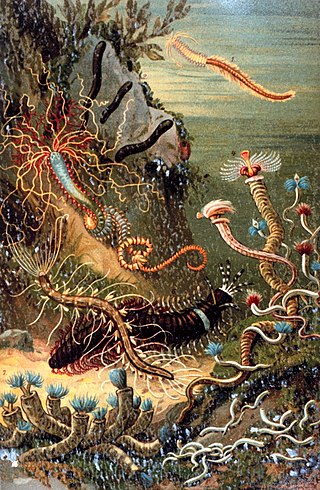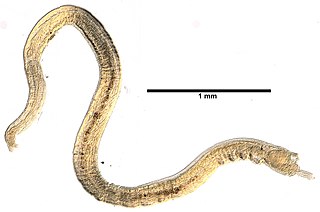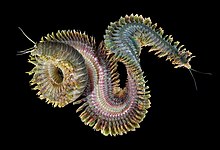
Polychaeta is a paraphyletic class of generally marine annelid worms, commonly called bristle worms or polychaetes. Each body segment has a pair of fleshy protrusions called parapodia that bear many bristles, called chaetae, which are made of chitin. More than 10,000 species are described in this class. Common representatives include the lugworm and the sandworm or clam worm Alitta.

The Clitellata are a class of annelid worms, characterized by having a clitellum – the 'collar' that forms a reproductive cocoon during part of their life cycles. The clitellates comprise around 8,000 species. Unlike the class of Polychaeta, they do not have parapodia and their heads are less developed.

Hesionidae are a family of phyllodocid "bristle worms". They are marine organisms. Most are found on the continental shelf; Hesiocaeca methanicola is found on methane ice, where it feeds on bacterial biofilms.
Rhodine is a genus of capitellid segmented worms in the family Maldanidae.

Phyllodocida is an order of polychaete worms in the subclass Aciculata. These worms are mostly marine, though some are found in brackish water. Most are active benthic creatures, moving over the surface or burrowing in sediments, or living in cracks and crevices in bedrock. A few construct tubes in which they live and some are pelagic, swimming through the water column. There are estimated to be more than 4,600 accepted species in the order.

Arenicolidae is a family of marine polychaete worms. They are commonly known as lugworms and the little coils of sand they produce are commonly seen on the beach. Arenicolids are found worldwide, mostly living in burrows in sandy substrates. Most are detritivores but some graze on algae.

Palpata is a subclass of polychaete worm. Members of this subclass are mostly deposit feeders on marine detritus or filter feeders. Palpata has become superfluous with the elevation of Canalipalpata to subclass.

The annelids, also known as the segmented worms, are a large phylum, with over 22,000 extant species including ragworms, earthworms, and leeches. The species exist in and have adapted to various ecologies – some in marine environments as distinct as tidal zones and hydrothermal vents, others in fresh water, and yet others in moist terrestrial environments.

Flabelligeridae is a family of polychaete worms, known as bristle-cage worms, notable for their cephalic cage: long slender chaetae forming a fan-like arrangement surrounding the eversible head. Unlike many polychaetes, they also have large, pigmented, complex eyes.

Siphonostomites hesionoides is a species of polychaete annelid known only from subtidal lagoon deposits from the Early Eocene of Monte Bolca, Verona, Italy.
Ysideria is a genus of marine polychaete worms belonging to the family Polynoidae, the scale worms. Ysideria contains a single species, Ysideria hastata which is known from the North Pacific Ocean off the coast of California at depths of about 50–60 m.

Maldanidae is a family of more than 200 species of marine polychaetes commonly known as bamboo worms or maldanid worms. They belong to the order Capitellida, in the phylum Annelida. They are most closely related to family Arenicolidae, and together form the clade Maldanomorpha.
Rhodininae is a subfamily of marine polychaete worms in the family Maldanidae.

Sedentaria is a diverse clade of annelid worms. It is traditionally treated as a subclass of the paraphyletic class Polychaeta, but it is also a monophyletic group uniting several polychaetes and the monophyletic class Clitellata. It is the sister group of Errantia.
Lumbriclymeninae is a subfamily of marine polychaete worms in the family Maldanidae.
Notoproctus is a genus of marine polychaete worms in the family Maldanidae. It is the only member of the subfamily Notoproctinae.

Pleistoannelida is a group of annelid worms that comprises the vast majority of the diversity in phylum Annelida. Discovered through phylogenetic analyses, it is the largest clade of annelids, comprised by the last common ancestor of the highly diverse sister groups Errantia and Sedentaria and all the descendants of that ancestor. Most groups in the Clade find their ancestors within the Cambrian explosion when Annelid diversity expanded dramatically. The Pleistoannelida clade covers a variety of traits. However, the evolution of simple to complex eyes, developed papillae for burrowing, and for some specialized radioles for feeding can be seen universally across every species. New findings have discovered the range of Annelid diversity have led to uncertainty if groups with developed ancestral traits should remain within the clade. Furthermore There's been a lack of recently discovered Annelid traits being used in the categorization of groups within the clade, leading to many hypothesis on how to do so and which should remain within the clade. Currently three smaller clades that were originally a part of the groups Errantia and Sedentaria have been proven to fall outside while still being connected to the basal groups.

Orbiniida is an order of small polychaete worms in the phylum Annelida. It is the earliest diverging clade in Sedentaria. Along with Protodriliformia, this order is composed of meiofaunal marine worms formerly known as "archiannelids". These worms inhabit the marine interstitial ecosystem, the space between sand grains.

Protodriliformia is a clade of small marine polychaetes, comprised by the groups of meiofaunal interstitial worms Protodrilida and Polygordiidae, formerly considered "archiannelids". It is the most basal clade of Errantia.













